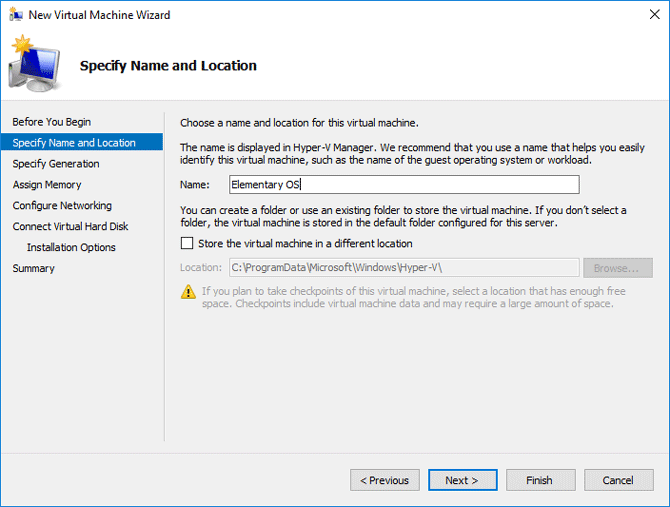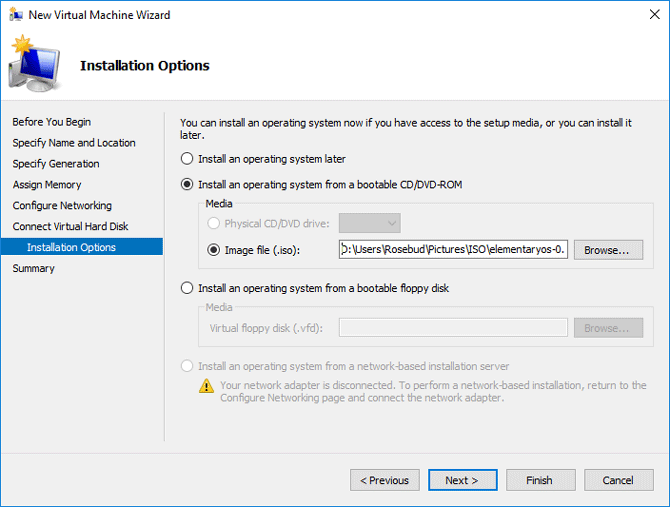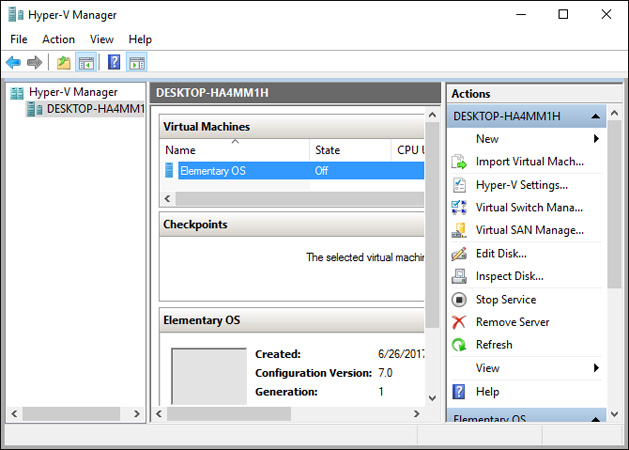Instructions for using Hyper-V to run Linux Distro on Windows 10
Each operating system on the computer will create an available environment for users to view, edit and run files. However, very few people are interested in using two or more operating systems on a single computer. If you want to try a new Linux distribution counter, you can use Hyper-V virtualization technology under the wire without formatting the hard drive or booting the dual system.
- Which distro should I use with Linux?
- Which Linux distros will Windows 10 put into Windows 10?
According to Microsoft, Hyper-V is available on 64-bit versions of Windows Professional, Enterprise and Education and newer versions except Windows Home.
Let us learn how to use Hyper-V to run any Linux distro on Windows 10!
Install Hyper-V
In general, the ways to install Hyper-V are quite simple, in which the simplest way is PowerShell and Windows Features.
For PowerShell, open the PowerShell application by clicking on the Start menu and typing PowerShell . Right-click the Windows PowerShell option and select Run as administrator . Then enter the following parameters in PowerShell:
Enable-WindowsOptionalFeature -Online -FeatureName: Microsoft-Hyper-V -All
Press Enter and you will be prompted to download Hyper V. You can also download Hyper V using the GUI (GUI) by typing windows features into the Start menu and clicking the Turn Windows features option on or off .

Activate the Hyper V option and select OK to download.
Running Linux from Hyper V
Now we can start by opening the Hyper-V Manager. Open the Start menu and type hyper v to see this option.
Next, we will need to create a virtual machine from the ISO file. Right-click on the parameter named DESKTOP on the left side of the window, below the Hyper-V Manager. Select New> Virtual Machine .

This will open the Virtual Machine Wizard. This wizard will guide you through the process of creating a virtual machine.
Follow the wizard's instructions but note the following:
- Assign Memory: You will specify the size of the boot RAM for the virtual machine. Remember, your RAM limit determines the overall speed of the virtual machine. Try to keep the virtual machine in good working order - 4 GB will allow your virtual machine to run standard applications and 8 GB to run games that use a lot of machine resources. To make sure your virtual machine runs smoothly, check Use Dynamic Memory for this virtual machine.
- Connect Virtual Hard Disk: Select Create a virtual hard disk . With Size parameters, remember that it includes both the operating system size and the additional memory of the files and programs. For example, Windows 10 will account for about 20 GB for the 64-bit version.
Go to Installation Options . In this window, select Install an operating system from a bootable CD / DCD-ROM . Next, select the Image file button (.iso) and select the ISO file via the Browse button.

Activate and use virtual machines
Now that you have created a virtual machine, you need to activate and open the virtual machine to use it.

You will see your operating system installed under the main virtual machine window. Right-click on the virtual machine and select Start. When its state is set to Running , you can start the virtual machine. Right-click on the running computer and select Connect. This will open ISO:

Install your operating system like other operating systems. Now you have a virtual machine of your Linux distribution. Now you can try a Linux distribution in a safe environment.
What is your favorite virtual machine software? Let us know by commenting below!
You should read it
- 7 Enterprise Linux Server Distributions
- 6 best Linux distros for gaming
- Top 8 most beautiful Linux distributions in 2022
- An Introduction to Spiral Linux: A Distro for Linux Beginners
- 8 easy tools to create your own Linux Distro
- What do you know about Linux distros?
- Instructions for installing basic Arch Linux
- 17 lightweight Linux distributions bring new life to old computers
May be interested
- 3 ways to try Linux without using USB
 many people think that the only way to experience linux on a computer is to create a bootable usb. in fact, there are simpler methods to try a linux distribution (distro) without booting from usb.
many people think that the only way to experience linux on a computer is to create a bootable usb. in fact, there are simpler methods to try a linux distribution (distro) without booting from usb. - What do you know about Linux distros?
 linux has existed for nearly 30 years, this is a historic journey. if you are interested in the history of some of the major linux distributions, read the following article.
linux has existed for nearly 30 years, this is a historic journey. if you are interested in the history of some of the major linux distributions, read the following article. - How to set Linux distro version to WSL 1 / WSL 2 in Windows 10
 this guide will show you how to set the linux distro version to wsl 1 or wsl 2 in windows 10.
this guide will show you how to set the linux distro version to wsl 1 or wsl 2 in windows 10. - 7 great Linux distro media centers for HTPC
 if you are looking for an outdated linux media center or an alternative to kodibuntu, try the following open source htpc operating systems.
if you are looking for an outdated linux media center or an alternative to kodibuntu, try the following open source htpc operating systems. - These Linux distros are used in IoT devices
 even the simplest iot devices run software to stay active and most of these devices are running linux distro.
even the simplest iot devices run software to stay active and most of these devices are running linux distro. - Why is Robolinux the best Linux distro for Windows users?
 robolinux is a debian-based operating system, with a heavy emphasis on windows and linux integration. that makes robolinux the best linux version for windows users.
robolinux is a debian-based operating system, with a heavy emphasis on windows and linux integration. that makes robolinux the best linux version for windows users. - 5 reasons why Linux distros create their own desktop environment
 most of us don't think of the desktop as separate from the operating system. the desktop is what you see on the screen - as with windows or macos. on linux, desktop options are extremely diverse.
most of us don't think of the desktop as separate from the operating system. the desktop is what you see on the screen - as with windows or macos. on linux, desktop options are extremely diverse. - How to check if your computer is running Windows 10 Hyper-V?
 on windows 10, windows 8.1 and windows 8 have added client hyper-v so you can run the guest operating system on the virtual machine. hyper-v is microsoft's hypervisor on windows. it was originally developed for windows server 2008 and then supported by the windows client operating system.
on windows 10, windows 8.1 and windows 8 have added client hyper-v so you can run the guest operating system on the virtual machine. hyper-v is microsoft's hypervisor on windows. it was originally developed for windows server 2008 and then supported by the windows client operating system. - 17 lightweight Linux distributions bring new life to old computers
 older computers are often slow and upgrading components such as ram, cpu and hard drive can alleviate performance problems. however, the best solution to bring new life to your old computer is to install a compact linux distribution.
older computers are often slow and upgrading components such as ram, cpu and hard drive can alleviate performance problems. however, the best solution to bring new life to your old computer is to install a compact linux distribution. - How to install Hyper Terminal in Ubuntu 20.04
 hyper is an open source application supported on all three major platforms: windows, linux, and macos. in this tutorial, tipsmake.com will explain how to install hyper terminal in ubuntu system.
hyper is an open source application supported on all three major platforms: windows, linux, and macos. in this tutorial, tipsmake.com will explain how to install hyper terminal in ubuntu system.










 Some tips to customize Taskbar on Windows 10 effectively
Some tips to customize Taskbar on Windows 10 effectively How to fix Working On It on File Explorer Windows 10
How to fix Working On It on File Explorer Windows 10 How to optimize Steam download speed in Windows 10
How to optimize Steam download speed in Windows 10 Instructions for downloading movies from Netflix in Windows 10
Instructions for downloading movies from Netflix in Windows 10 How to create transparent background mode on Windows 10
How to create transparent background mode on Windows 10 9 customizable 'power' tools Windows 10 (sequel)
9 customizable 'power' tools Windows 10 (sequel)